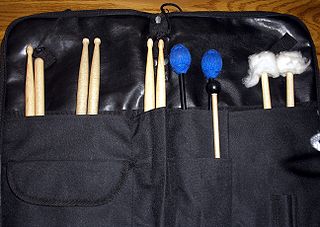
A percussion instrument is a musical instrument that is sounded by being struck or scraped by a beater including attached or enclosed beaters or rattles struck, scraped or rubbed by hand or struck against another similar instrument. The percussion family is believed to include the oldest musical instruments, following the human voice.
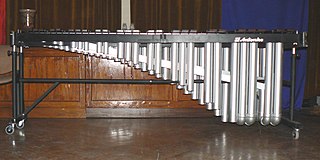
The marimba is a percussion instrument consisting of a set of wooden bars struck with yarn or rubber mallets to produce musical tones. Resonators or pipes suspended underneath the bars amplify their sound. The bars of a chromatic marimba are arranged like the keys of a piano, with the groups of two and three accidentals raised vertically, overlapping the natural bars to aid the performer both visually and physically. This instrument is a type of idiophone, but with a more resonant and lower-pitched tessitura than the xylophone. A person who plays the marimba is called a marimbist or a marimba player.

A glockenspiel is a percussion instrument composed of a set of tuned keys arranged in the fashion of the keyboard of a piano. In this way, it is similar to the xylophone; however, the xylophone's bars are made of wood, while the glockenspiel's are metal plates or tubes, thus making it a metallophone. The glockenspiel, moreover, is usually smaller and higher in pitch.
Throughout history, various methods of musical instrument classification have been used. The most commonly used system divides instruments into string instruments, woodwind instruments, brass instruments and percussion instruments; however, other schemes have been devised.

A mallet percussion instrument is a melodic percussion instrument played in a particular fashion, with mallets. Mallet percussion includes:

In a marching band or a drum and bugle corps, the front ensemble or pit is the stationary percussion ensemble. This ensemble is typically placed in front of the football field, though some groups will work the front ensemble into a tight pod onto the marching field. Some high school marching bands opt not to march any percussion instruments, but instead have a "full" front ensemble.

The Radiodrum or radio-baton is a musical instrument played in three-dimensional space using two mallets. It was developed at Bell Labs in the 1980s, originally to be a three-dimensional computer mouse. Currently it is used as a musical instrument similar to a MIDI controller in the sense that it has no inherent sound or effect, but rather produces control signals that can be used to control sound-production As such, it can be thought of as a general telepresence input device. The radiodrum works in a similar way to the theremin, which uses magnetic capacitance to locate the position of the drumsticks. The two mallets act as antennas transmitting on slightly different frequencies and the drum surface acts as a set of antennas. The combination of the antenna signals is used to derive X, Y and Z.

Stagg music is a Belgian musical instrument company headquartered in Brussels, currently a subsidiary of EMD Music. The company produce a wide range of musical instruments, which includes string instruments, percussion instruments, tuned metal, free reed and brass instruments as well as effects units and other accessories.
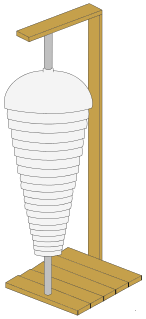
A bell tree, also known as Pakistan tree bells or Chinese bell tree, is a percussion instrument, consisting of vertically nested inverted metal bowls. The bowls, placed on a vertical rod, are arranged roughly in order of pitch. The number of bowls can vary between approximately 14 and 28. An effective glissando is produced by sliding a triangle beater, a glockenspiel mallet, or a xylophone mallet down the length of the tree. The bells are usually pitched to microtonal intervals and do not represent any formal scale. When a glissando is played, the inexactness of the order of the bowls' pitch is unnoticeable, merely creating a fuller sound.

The ranat ek is a Thai musical instrument in the percussion family that consists of 21 wooden bars suspended by cords over a boat-shaped trough resonator and struck by two mallets. It is used as a leading instrument in the piphat ensemble.

The Roneat Ek or Roneat Aek is a xylophone used in the Khmer classical music of Cambodia. It is built in the shape of a curved, rectangular shaped boat. It has twenty-one thick bamboo or hard wood bars that are suspended from strings attached to the two walls. They are cut into pieces of the same width, but of different lengths and thickness. Originally these instruments were highly decorated with inlay and carvings on the sides of the sound box. Now they are simpler. The Roneat is played in the Pinpeat ensemble. In that ensemble, sits on the right of the Roneat Thung, a lower-pitched xylophone. The roneat ek is the analogous equivalent to the Thai xylophone called ranat ek, and the Burmese bamboo xylophone called "pattala".
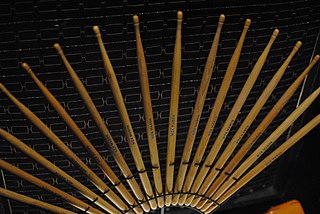
A drumstick is a type of percussion mallet used particularly for playing snare drum, drum kit and some other percussion instruments, and particularly for playing unpitched percussion.
Clair Omar Musser (1901–1998) was a marimba virtuoso, a conductor and promoter of marimba orchestras, a composer, a teacher, a designer of keyboard percussion instruments, an inventor, and an engineer for Hughes Aircraft.

A keyboard percussion instrument, shortened as 'Keyperc', is a chromatic melodic percussion instrument arranged in a similar pattern to a piano keyboard and played with hands or percussion mallets. Although, KeyPerc instruments for children may be diatonic or pentatonic.

There are several overlapping schemes for the classification of percussion instruments.
Roneat is the generic Khmer word for referring to several types of xylophones used in traditional Cambodian music; the pinpeat and mohaori.
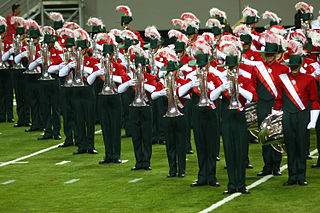
The implementation of sound technology by International Drum Corps is a phenomenon in the twenty-first century marching arts. Since 2004, many corps have used electronics to amplify, alter, and add to the sound of their ensembles.

